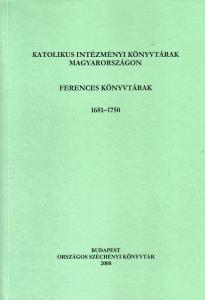
Libraries of the Catholic Church in Hungary. Franciscan Libraries 1681–1750
Libraries of the Catholic Church in Hungary. Franciscan Libraries 1681–1750
Arranged for the press by Edina Zvara
Edited by István Monok
NSZL–University of Szeged, Faculty of Old Hungarian Literature, Budapest–Szeged, 2008., 26+384 pages
[Database for the History of the Cultural Movements of the XIV–XVIII. century, 19/3., Series edited by Bálint Keserű, Mihály Balázs]
ISBN 978 963 200 557 7
Database for the History of the Cultural Movements of the XIV-XVIII century is a series of the catalogues of private and public collections in the Early Modern Period. Edited at the Faculty of Library Studies of Szeged University and published by National Széchényi Library, volume 19/3 is dedicated to the preserved catalogues of Franciscan libraries.
In the preface, Edina Zvara offers a brief resume of the history of the Franciscan Order in Hungary in the 17th and 18th century. The Franciscan was the only religious order founded in the Middle Ages that continued functioning under the Ottoman subjection. Then, at the end of the 17th century, after reformation and renovation, and although with much less monastic quarters, they counted with approximately 3500 members. The growth of the Order can also be measured by the number and extent of the libraries and collections. At the beginning of the 18th century, the libraries of Eperjes/Prešov (Minorite), Németújvár/Güssing (Marian), Csíksomlyó/Șumuleu Ciuc (Salvatorian then Stephanite) and Szakolca/Skalica (Salvatorian) counted with more than a thousand volumes, but the collection of Gyöngyös (Salvatorian), although without a preserved catalogue to document it, might have been of similar size. To make the series complete, our publication apart from the indexes of significant monastic quarters also contains the existing book lists of parish churches, and a collection of the Pauline and the Prémontré Order. (As the book covers do not reveal it clearly, researchers of modern library catalogues have to do a great deal of work to find out where exactly an index belongs.)
To have a complete picture of the detailed contents of monastic libraries, a thorough analysis of the catalogues is needed. It is a pleasure to know that the Szeged book history workshop and church historians have already carried out some partial analysis. An interesting chapter of Edina Zvara’s preface is the presentation of sources available regarding Franciscan book and library use regulation, including the storage of books, cataloging, and the authorization for publishing.
Our volume lists the Franciscan book catalogues in time order. After each catalogue, a short resume presents the history of the library and indicates the research literature related. As these catalogues are transcribed literally (in old language) their use is made easier by the index of names and places with generally used names in literature and a rich system of references.
Shopping
Our publications are available in our bookshop, or can be ordered from the Publications Department of the NSZL using the contact details below: Főigazgatói Kabinet kiadványtára, Országos Széchényi Könyvtár, 1276 Budapest P.O. box 1205., phone: 06 1 232-3556, e-mail: kiadvanytar@oszk.hu.




